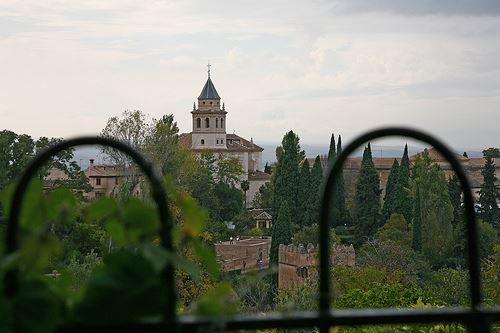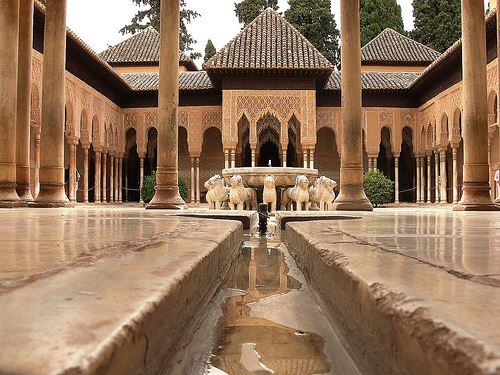The Alhambra is an Andalusian palace city located in Granada, Spain. This is a rich palace complex and strength (fortress or al-Qasr) that housed the monarch and the court of the United Nasrid Granada. Its real appeal, as in other Muslim works of the time, not only lies in the interior decoration of which is between the peaks of Andalusian art, but also in their localization and adaptation, creating a new landscape but fully integrated with existing nature. In 2011 he became the most visited monument in Spain, receiving a record number of 2.310.764 visitantes.

"La Alhambra", Granada, South of Spain, by Pixelmaniac, at flickr.com
Etymologically, "Alhambra" in Arabic is "al-Hamra '(الحمراء,' the Red '), from the name" al-Qal'a al-Hamra' ('red fortress'). In its evolution, Castilian sandwiched between m and r a b, as in "mat" which in classical Arabic was the meaning of 'redness', written as "al-humra." There are more theories to explain the origin of the name of the Alhambra, as there are other authors who argue that at the time the Alhambra was whitewashed Andalusian and its color was white. The name "red" because when it was built would be working at night, and night view from afar because of the torchlight, saw red. Other authors argue that "Alhambra" is simply the feminine name of its founder, Abu al-Ahmar, which in Arabic means 'the Red', being red.
The Alhambra is a walled city (medina) occupying most of the hill of La Sabika. Muslim Granada system had its own fortress, the Alhambra therefore could function autonomously from the city. In the Alhambra were all the facilities and necessary for the people living there: the royal palace, mosques, schools, workshops, etc..
In 1238, Granada enters through the gate of Elvira, and to occupy the Palace of the Wind Gallo, Mohamed Ben-Nazar (or Nasr), called Al-Ahmar the Red (as it had a red beard).
When Ben Al-Ahmar (Ben Mohamed Nazar) became the winner in Granada in the year 1238, the people received him with the cry of "Welcome the winner by the grace of Allah", he replied: "Only Allah Wins". This is the motto of the Nasrid coat and is written by the Alhambra. Ben Al-Hamar built the first nucleus of the palace. His son, Mohammed II, who was a friend of Alfonso X the Wise, fortified it.
The Alhambra in Granada style is the culmination of Andalusian art, what happened in the mid-fourteenth century Yusuf I, who built the Tower of Comares, and Mohamed V, who would build the Patio de los Leones.

"patio_leones_01", La Alhambra, Granada, South of Spain, by Javier Diaz, at flickr.com
In 1492, with the conquest of Granada by the Catholic Monarchs, the Alhambra became the royal palace. The Count of Tende, the Mendoza family, was the first Christian governor of the Alhambra. Hernando del Pulgar, chronicler of the time, says: "The Count of Tende and the supreme commander of Leon, Gutierrez de Cardenas, Ferdinand received the keys of Granada, Alhambra and entered the top of the Tower of Comares raised their cross and the flag. "
Napoleon's invasion was a negative event for the Alhambra. In 1812, the French army in their retreat from Granada, the Alhambra decided to fly with several explosive charges connected by a wildfire. By then it had come down some defensive towers, like the Tower of the Seven Floors. Only the courage of a Spanish soldier was able to avoid its total destruc-tion, to interrupt the course of the explosions.
The World Heritage Committee of Unesco declared the Alhambra and Generalife of Granada as a World Heritage Site at its meeting on November 2 - 1984 and five years later, the neighborhood of the Albaicin (Al Albayzín), old medieval Muslim , got the same name as an extension of the declaration as Cultural Patrimony of the Humanity of the Alhambra and the Generalife. The Alhambra was one of 21 finalists to be one of New Seven Wonders of the modern world, but ultimately was not chosen to join the group.
Patio de los leones
Its construction was begun in 1377 at the behest of Mohamed V, son of Yusuf I, being his most Abén Cecid mason, concluding thirteen years later. The Arabs of Granada, before calling the Patio de los Leones Sahan al-Osud, they did under the name of Al-Haram. Slightly trapezoidal in plan, the eastern side is greater than that given to the west (the Mocárabes room), the length of the whole, -219 feet, including rooms and Kings Mocárabes is equal to three times the width of the Patio your child or west side (73 feet) -, 5 surrounded by a gallery with 124 slender columns of white marble Macael (Almería), which are grouped, in addition to those exempt, set of two, three, and even four in the corners, supporting, or propping up only the filigree arches, being more symmetrical and asymmetrical sides minors, wards sendo those moving into the courtyard, at the intersection of transverse and longitudinal axis is located the source with the twelve lions which it is named. Around the bedrooms, private rooms of the sultan and wives upstairs open, lack of windows to look outside, but inside garden as befits the Muslim view of paradise. The land is now in the courtyard garden was. In each room 4 streams flow going to the center: the 4 rivers of Paradise. The columns are joined with lace panels that let in light. Cylindrical shafts very thin at the top rings, hooks on which are cubic inscriptions. The lead plates become gray horizontal vertical thrusts. The two temples they move to opposite sides of the courtyard are a reminder of the tent of the Bedouin. Are square, decorated with wooden domes are supported by muqarnas pendentives. The wing is the work of the nineteenth century. The entire gallery is covered with paneled tracery.
Fountain of Los Leones
The latest data obtained thanks to the restoration of the lions and the basin of the fountain were able to indicate that both the lions and the cup, dating from the fourteenth century and of the same origin and material (marble Macael, Almería) being made the source as a whole, so as lions cup at the same time. This finding is correcting the information indicating the source of the lions of a palace, the Alhambra before, belonging to the first dynasty vizier Ibn Nagrella Zirid Samuel. In turn, it has been discovered three types of lions on the basis of their formal differentiating column systems. Each is shaped by a group of four lions with similarity in two to two traits: nose, coat of hair, jaws and position and topography of the tail.
The source of the lions has several meanings or symbols, none of them substantiated. On the one hand the twelve lions have astrological symbolism, each lion refers to a zodiacal sign. Furthermore, it has a majestic political significance or which is related to King Solomon (the king architect) since there is an inscription referring to this source. Last and most important, refers to a heavenly symbol thus referring to the source, native life and the 4 rivers of Paradise. But what if you can say is that the source itself is an allegory of the power that resides in the sultan.
Ten years ago, it was started the restoration of the "Patio de los leones", in order to recover the original color of the marbel of the lions.At least, today, the Board of the Alhambra reopens this majestic "Patio de los leones", 700 years after its construction.
It is worth to come to visit La Alhambra.Moreover, because all of Granada is a very beautiful city.
Kind regards,
Luis
Sponsored by Costaluz Lawyers
(Click down here):